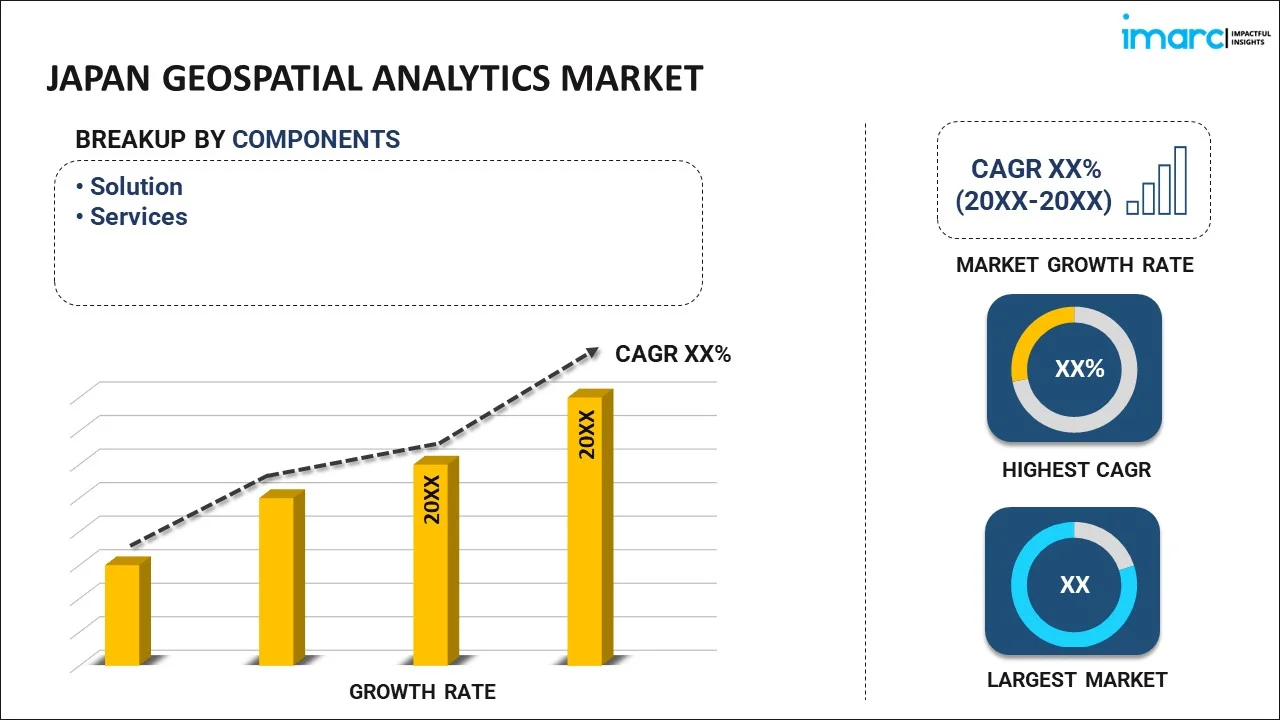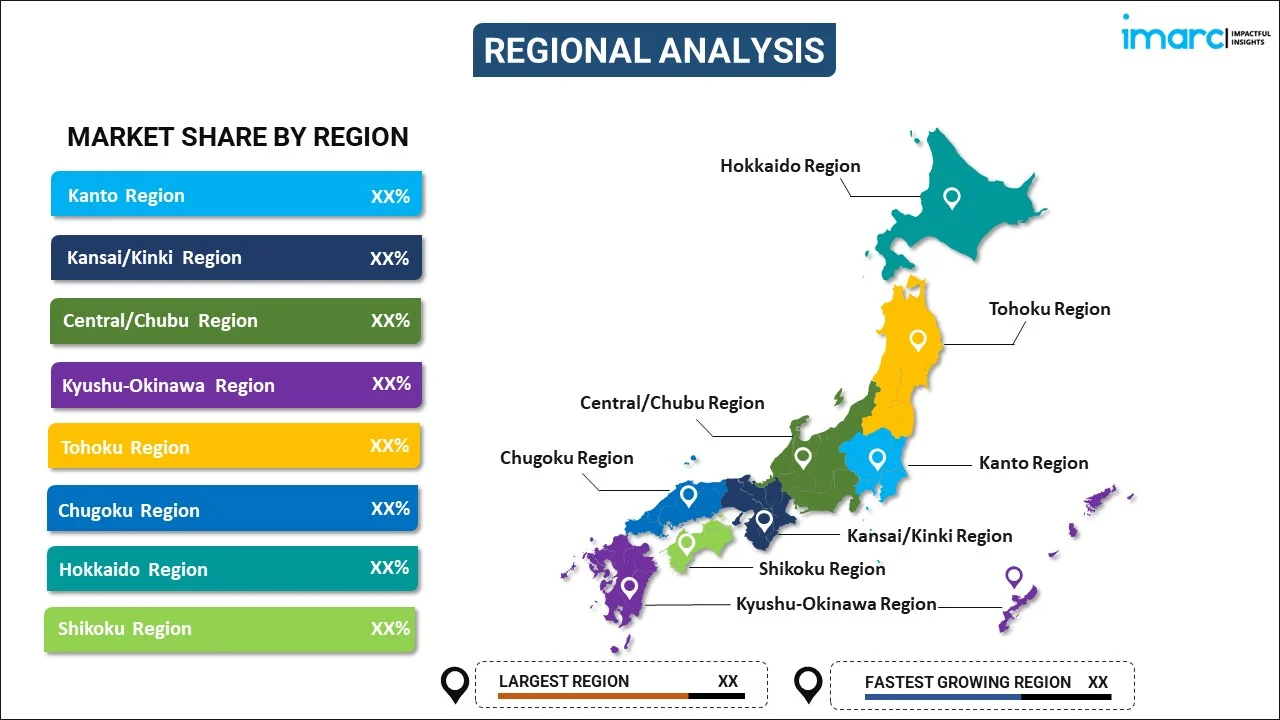
Japan Geospatial Analytics Market Report by Component (Solution, Services), Type (Surface and Field Analytics, Network and Location Analytics, Geovisualization, and Others), Technology (Remote Sensing, GIS, GPS, and Others), Enterprise Size (Large Enterprises, Small and Medium-sized Enterprises), Deployment Mode (On-premises, Cloud-based), Vertical (Automotive, Energy and Utilities, Government, Defense and Intelligence, Smart Cities, Insurance, Natural Resources, and Others), and Region 2025-2033
Market Overview:
Japan geospatial analytics market size reached USD 6,772 Million in 2024. Looking forward, IMARC Group expects the market to reach USD 19,410 Million by 2033, exhibiting a growth rate (CAGR) of 12.4% during 2025-2033. The increasing usage of location-based services in industries such as retail, transportation, and logistics that require personalized delivery as well as location-specific information and services to their customers is primarily driving the market.
|
Report Attribute
|
Key Statistics
|
|---|---|
|
Base Year
|
2024 |
|
Forecast Years
|
2025-2033
|
|
Historical Years
|
2019-2024
|
| Market Size in 2024 | USD 6,772 Million |
| Market Forecast in 2033 | USD 19,410 Million |
| Market Growth Rate (2025-2033) | 12.4% |
Geospatial analytics is a field of data analysis that focuses on using location-based information to gain insights and make informed decisions. It involves the collection, processing, and interpretation of geographic data from various sources, such as satellites, GPS devices, and sensors. By combining this spatial data with traditional data sets, geospatial analytics enables organizations to uncover patterns, trends, and relationships that may not be apparent through conventional analysis. This approach has diverse applications, from urban planning and environmental monitoring to logistics optimization and disaster management. Geospatial analytics empowers businesses and government agencies to answer critical questions related to resource allocation, risk assessment, and market intelligence. It also plays a vital role in fields like agriculture, where precise geographic information can enhance crop management and yield predictions. Overall, geospatial analytics harnesses the power of location data to provide valuable insights for better decision-making and problem-solving in a wide range of industries.
Japan Geospatial Analytics Market Trends:
The geospatial analytics market in Japan is multifaceted and interconnected, propelling this sector into rapid growth. Firstly, the proliferation of satellite and aerial imagery, coupled with advancements in remote sensing technologies, has generated an unprecedented influx of geospatial data. Consequently, this influx serves as a fundamental driver, fostering a rich source of information for businesses and governments alike. Moreover, the rising need for precise location-based insights in various industries, from urban planning to agriculture, further accelerates market growth. These industries recognize that geospatial analytics can optimize decision-making processes by providing actionable intelligence on resource allocation, risk assessment, and operational efficiency. Additionally, growing awareness of environmental sustainability has heightened the demand for geospatial analytics. Companies and governments are leveraging geospatial insights to monitor and mitigate environmental impacts, such as deforestation and climate change, which, in turn, promotes further market expansion. Furthermore, the integration of geospatial data with other emerging technologies like artificial intelligence and the Internet of Things (IoT) that allows for predictive and prescriptive analytics, thereby enhancing businesses' ability to anticipate trends and make data-driven choices, is expected to drive the market in Japan during the forecast period.
Japan Geospatial Analytics Market Segmentation:
IMARC Group provides an analysis of the key trends in each segment of the market, along with forecasts at the country level for 2025-2033. Our report has categorized the market based on component, type, technology, enterprise size, deployment mode, and vertical.
Component Insights:

- Solution
- Services
The report has provided a detailed breakup and analysis of the market based on the component. This includes solution and services.
Type Insights:
- Surface and Field Analytics
- Network and Location Analytics
- Geovisualization
- Others
A detailed breakup and analysis of the market based on the type have also been provided in the report. This includes surface and field analytics, network and location analytics, geovisualization, and others.
Technology Insights:
- Remote Sensing
- GIS
- GPS
- Others
The report has provided a detailed breakup and analysis of the market based on the technology. This includes remote sensing, GIS, GPS, and others.
Enterprise Size Insights:
- Large Enterprises
- Small and Medium-sized Enterprises
A detailed breakup and analysis of the market based on the enterprise size have also been provided in the report. This includes large enterprises and small and medium-sized enterprises.
Deployment Mode Insights:
- On-premises
- Cloud-based
The report has provided a detailed breakup and analysis of the market based on the deployment mode. This includes on-premises and cloud-based.
Vertical Insights:
- Automotive
- Energy and Utilities
- Government
- Defense and Intelligence
- Smart Cities
- Insurance
- Natural Resources
- Others
A detailed breakup and analysis of the market based on the vertical have also been provided in the report. This includes automotive, energy and utilities, government, defense and intelligence, smart cities, insurance, natural resources, and others.
Regional Insights:

- Kanto Region
- Kansai/Kinki Region
- Central/ Chubu Region
- Kyushu-Okinawa Region
- Tohoku Region
- Chugoku Region
- Hokkaido Region
- Shikoku Region
The report has also provided a comprehensive analysis of all the major regional markets, which include Kanto Region, Kansai/Kinki Region, Central/ Chubu Region, Kyushu-Okinawa Region, Tohoku Region, Chugoku Region, Hokkaido Region, and Shikoku Region.
Competitive Landscape:
The market research report has also provided a comprehensive analysis of the competitive landscape. Competitive analysis such as market structure, key player positioning, top winning strategies, competitive dashboard, and company evaluation quadrant has been covered in the report. Also, detailed profiles of all major companies have been provided.
Japan Geospatial Analytics Market Report Coverage:
| Report Features | Details |
|---|---|
| Base Year of the Analysis | 2024 |
| Historical Period | 2019-2024 |
| Forecast Period | 2025-2033 |
| Units | Million USD |
| Scope of the Report | Exploration of Historical Trends and Market Outlook, Industry Catalysts and Challenges, Segment-Wise Historical and Future Market Assessment:
|
| Components Covered | Solution, Services |
| Types Covered | Surface and Field Analytics, Network and Location Analytics, Geovisualization, Others |
| Technologies Covered | Remote Sensing, GIS, GPS, Others |
| Enterprise Sizes Covered | Large Enterprises, Small and Medium-sized Enterprises |
| Deployment Modes Covered | On-premises, Cloud-based |
| Verticals Covered | Automotive, Energy and Utilities, Government, Defense and Intelligence, Smart Cities, Insurance, Natural Resources, Others |
| Regions Covered | Kanto Region, Kansai/Kinki Region, Central/ Chubu Region, Kyushu-Okinawa Region, Tohoku Region, Chugoku Region, Hokkaido Region, Shikoku Region |
| Customization Scope | 10% Free Customization |
| Post-Sale Analyst Support | 10-12 Weeks |
| Delivery Format | PDF and Excel through Email (We can also provide the editable version of the report in PPT/Word format on special request) |
Key Questions Answered in This Report:
- How has the Japan geospatial analytics market performed so far and how will it perform in the coming years?
- What has been the impact of COVID-19 on the Japan geospatial analytics market?
- What is the breakup of the Japan geospatial analytics market on the basis of component?
- What is the breakup of the Japan geospatial analytics market on the basis of type?
- What is the breakup of the Japan geospatial analytics market on the basis of technology?
- What is the breakup of the Japan geospatial analytics market on the basis of enterprise size?
- What is the breakup of the Japan geospatial analytics market on the basis of deployment mode?
- What is the breakup of the Japan geospatial analytics market on the basis of vertical?
- What are the various stages in the value chain of the Japan geospatial analytics market?
- What are the key driving factors and challenges in the Japan geospatial analytics?
- What is the structure of the Japan geospatial analytics market and who are the key players?
- What is the degree of competition in the Japan geospatial analytics market?
Key Benefits for Stakeholders:
- IMARC’s industry report offers a comprehensive quantitative analysis of various market segments, historical and current market trends, market forecasts, and dynamics of the Japan geospatial analytics market from 2019-2033.
- The research report provides the latest information on the market drivers, challenges, and opportunities in the Japan geospatial analytics market.
- Porter's five forces analysis assist stakeholders in assessing the impact of new entrants, competitive rivalry, supplier power, buyer power, and the threat of substitution. It helps stakeholders to analyze the level of competition within the Japan geospatial analytics industry and its attractiveness.
- Competitive landscape allows stakeholders to understand their competitive environment and provides an insight into the current positions of key players in the market.
Need more help?
- Speak to our experienced analysts for insights on the current market scenarios.
- Include additional segments and countries to customize the report as per your requirement.
- Gain an unparalleled competitive advantage in your domain by understanding how to utilize the report and positively impacting your operations and revenue.
- For further assistance, please connect with our analysts.
 Inquire Before Buying
Inquire Before Buying
 Speak to an Analyst
Speak to an Analyst
 Request Brochure
Request Brochure
 Request Customization
Request Customization




.webp)




.webp)












